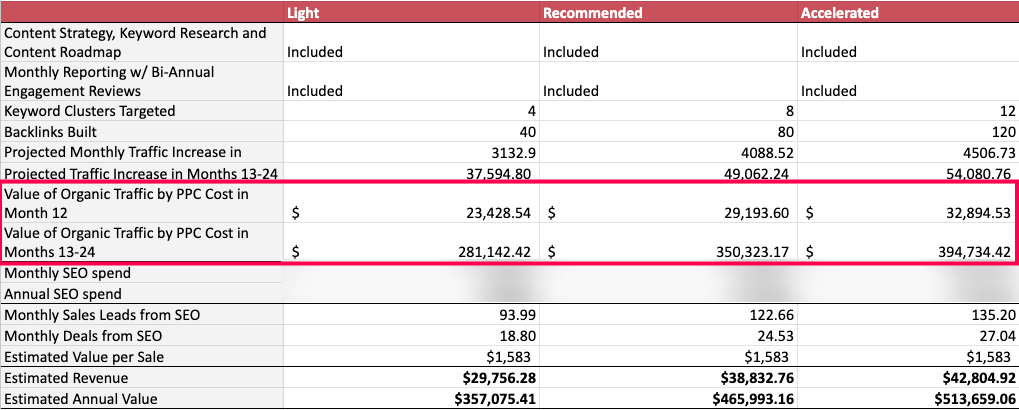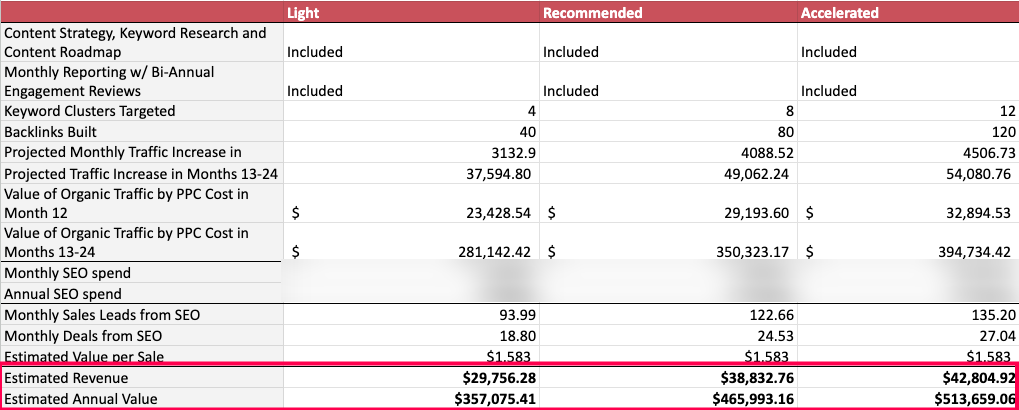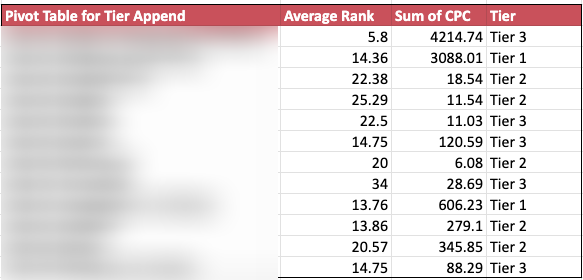Keyword ROI Exercise Explained
At Nexus Marketing, we pride ourselves on using data-driven strategies to inform our work with partners and clients.
One of our tools is the Keyword ROI Estimating Exercise. This tool enables us to evaluate the potential ROI of an investment in SEO through two lenses:
- Value of Organic Traffic by PPC Cost: This approach helps us quantify the value of organic traffic by comparing it to the equivalent cost of paid traffic. By analyzing the estimated cost-per-click (CPC) for specific keywords, we can calculate how much it would cost to acquire the same traffic through pay-per-click advertising. This allows us to determine the monetary value of organic traffic, demonstrating how much businesses save by ranking organically instead of relying solely on paid campaigns.

- Value of Organic Traffic by Estimated Monthly Revenue: This focuses on calculating the potential revenue generated by organic traffic. We calculate the expected monthly revenue from those visitors by estimating the number of visitors a keyword brings to the site and applying conversion rates (such as 3% visitors to leads and 20% leads to closed deals). This method offers a more direct insight into how keyword rankings translate into actual business outcomes, making it easier for clients to see the real-world financial impact of SEO efforts.

In this blog post, we’ll explain the methodology behind the document.
1. Organic CTR by SERP Position: Why Ranking Matters
When assessing the value of organic traffic, the position of a keyword on the search engine results page (SERP) plays a crucial role. Our analysis leverages industry-standard click-through rates (CTR) by position to determine how much traffic a given ranking will generate.
Here’s a breakdown of the average CTR by SERP position:
| Position | Average CTR |
|---|---|
| 1 | 28.50% |
| 2 | 15.70% |
| 3 | 11.00% |
| 4 | 8.00% |
| 5 | 7.20% |
| 6 | 6.20% |
| 7 | 4.20% |
| 8 | 3.80% |
| 9 | 3.10% |
| 10 | 2.50% |
| 11 | 1.80% |
| 12 | 1.70% |
| 13 | 1.50% |
| 14 | 1.30% |
| 15 | 1.10% |
| 16 | 1.00% |
| 17 | 0.90% |
| 18 | 0.80% |
| 19 | 0.70% |
| 20 | 0.60% |
This data shows that the first position captures a significant portion of search traffic—28.5% of all clicks.
However, as rankings drop, the CTR declines sharply, with the 10th position receiving only 2.5% of clicks.
This steep drop-off emphasizes the importance of securing top rankings for your keywords. By understanding and applying these CTR metrics, we can estimate the potential traffic volume from organic search based on a keyword’s position, allowing us to calculate the expected value of that traffic for our clients.
2. Understanding Current Rankings
We analyze current keyword rankings, a critical step in the Keyword ROI Estimation Exercise. SEMRush provides real-time data on where a client’s website ranks for specific keywords, including metrics like search volume, keyword difficulty, and competitive insights.
Why Are Current Rankings Important?
Current rankings are a key performance indicator for any SEO strategy. They give us a clear picture of a website’s visibility in search engines and help us identify which keywords drive traffic and which need further optimization.
By consistently monitoring rankings, we can measure the effectiveness of our SEO efforts and make data-driven decisions to improve keyword positioning.
Ranking data also helps us prioritize our SEO initiatives.
For example, a keyword ranked in the top 3 positions is likely generating significant traffic already, but even minor improvements in those rankings can lead to substantial traffic gains. Conversely, keywords ranked on the second or third page have room for significant growth, and targeting these can unlock new traffic streams.
Having a business’ current rankings is the foundation of our ROI estimate.
Step 3: Initial Keyword Research and Preliminary Content Strategy
The third step in our process involves conducting initial keyword research to identify potential topics tailored to your business.
Using tools like SEMRush and insights from our initial discussions, we analyze keywords and group them into relevant keyword clusters.
These clusters represent groups of related terms with common themes or search intent.
Once we have these keyword clusters, we map them to potential content opportunities.
By organizing the clusters into strategic cornerstone content ideas, we can create or optimize pages that have the potential to rank for multiple keywords at once.
Step 4: Tiering Content Based on Engagement Levels and Traffic Value
In Step 4, we prioritize and tier the potential cornerstone content ideas by evaluating two key factors: traffic value and the speed of execution. We determine the traffic value by analyzing the estimated CPC (cost-per-click) for the keywords associated with each content idea. This helps us understand the monetary value of ranking organically for these keywords compared to the cost of driving the same traffic through paid advertising.
Next, we assess how quickly we can take advantage of the opportunity based on the current state of your website and existing content. With this information, we assign each cornerstone content idea to one of three tiers:
- Tier 1: High-value, high-priority content with the most significant potential for immediate traffic and business impact. These topics typically align with high CPC keywords and can be executed quickly.
- Tier 2: Mid-level opportunities that provide solid traffic potential but may take more time to produce or optimize. These are essential pieces of content that will drive value over the medium term.
- Tier 3: Long-term opportunities that are a lower priority but still valuable. These content ideas usually target lower CPC keywords or keywords with more gradual growth potential and are addressed in later stages of the strategy.
By assigning these tiers, we ensure that our efforts are focused on maximizing ROI in a structured, strategic way. It also clarifies which keyword clusters will be tackled first, second, and third, allowing for a phased approach that delivers results at each engagement stage.

Step 5: Calculating Current and Future Traffic Value by Strategy Tier
In Step 5, we quantify your website traffic’s current and potential future value by evaluating current state traffic and future traffic estimates for each strategy tier.
We begin by calculating the current traffic value based on existing organic traffic and its estimated CPC value.
This allows us to understand how much it would cost to acquire this traffic via paid search, giving us a baseline to measure the effectiveness of your current SEO efforts.
Next, we project future traffic estimates by strategy tier.
Using data from keyword rankings, CTR benchmarks, and search volume, we forecast the increase in traffic that can be expected after implementing content optimizations at each tier.
For each tier, we calculate the potential CPC savings by estimating the traffic’s worth if acquired through paid advertising instead of organic search.
This step helps quantify the ROI potential of your SEO strategy by clearly showing the value of improved rankings across different content tiers.
By comparing the current state traffic to the estimated future traffic, we can demonstrate the financial impact of moving forward with a well-defined content strategy, helping you prioritize investment based on expected returns.

Step 5: Estimating Revenue Based on Conversion Rates and Deal Value
In Step 5, we move beyond traffic estimates and calculate the estimated revenue that your SEO strategy can generate.
This is done by factoring in your business’s average deal value, visitor-to-lead conversion rate, and lead-to-close rate.
If you have this data available, we use your actual numbers to provide a precise estimate. However, if this information isn’t available, we rely on industry benchmarks to guide our estimates.
For instance, according to HubSpot’s sales statistics, the average sales close rate was 29% in 2023.
When working with our clients, we see 10 – 50% sales conversion rates based on the solution and industry. Based on three years of data across 50 clients, the average among clients serving a mission-driven sector is 20%, so we’ll use that baseline without the prospect having their own data.
Additionally, data from Geckoboard suggests that the visitor-to-lead conversion rate for B2B websites typically falls between 2.23% and 4.31%.
When working with our clients, we see 1 – 5% visitor-to-lead conversion rates based on the solution, industry, and what a lead is.
Based on three years of data across 50 clients, the average among clients serving a mission-driven sector is clients is 3%, so we’ll use that baseline without the prospect having their own data.
We can calculate potential revenue outcomes for your business by applying these benchmarks.
Here’s how it works:
- Estimate the number of leads based on your expected web traffic and your visitor-to-lead conversion rate.
- Estimate the number of closed deals by applying the lead-to-close rate to your total leads.
- Calculate the total revenue by multiplying your average deal value by the number of closed deals.
This approach allows us to create a clear picture of the financial impact of your SEO strategy.
Whether using your data or industry benchmarks, we can project the revenue potential for each tier of your content strategy, demonstrating the direct business value of optimizing your site for organic search.
Step 6: Finalize and Summarize Results
In the final step, we present the data and insights gathered throughout the keyword ROI estimation process in a clear, visual format, typically in a slide deck.
The slides summarize the key findings, including traffic value estimates, tiered content strategies, projected ROI, and the financial impact of your SEO efforts.
Our goal is to offer a comprehensive strategy overview focusing on measurable outcomes. Each slide highlights critical data points like:
- Projected monthly traffic increases for each engagement level (overview, light, recommended, and accelerated).
- The value of organic traffic is based on PPC cost, helping you visualize the cost savings from ranking organically versus paid search.
- Projected ROI, detailing the estimated increase in revenue based on your conversion rates, deal values, and traffic growth across the different content strategy tiers.
The slide deck serves as the final product of our analysis, ensuring that you have a clear and actionable plan for leveraging SEO to boost your traffic, generate leads, and increase revenue.
It also allows you to make informed decisions about future investments in your SEO strategy by showcasing the value and expected returns over the next 12 to 24 months.




